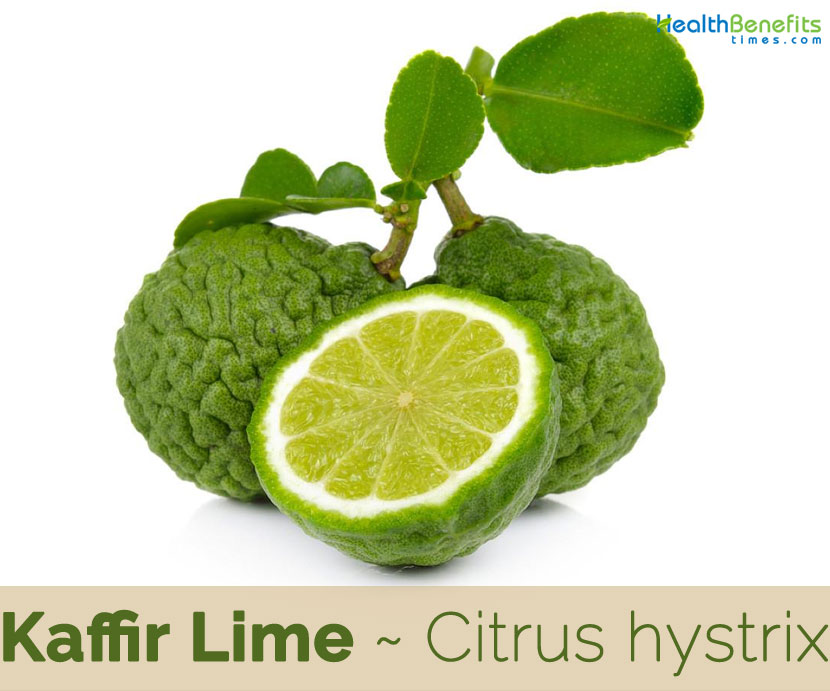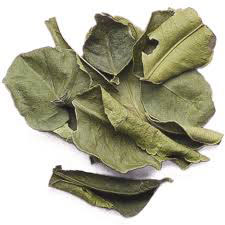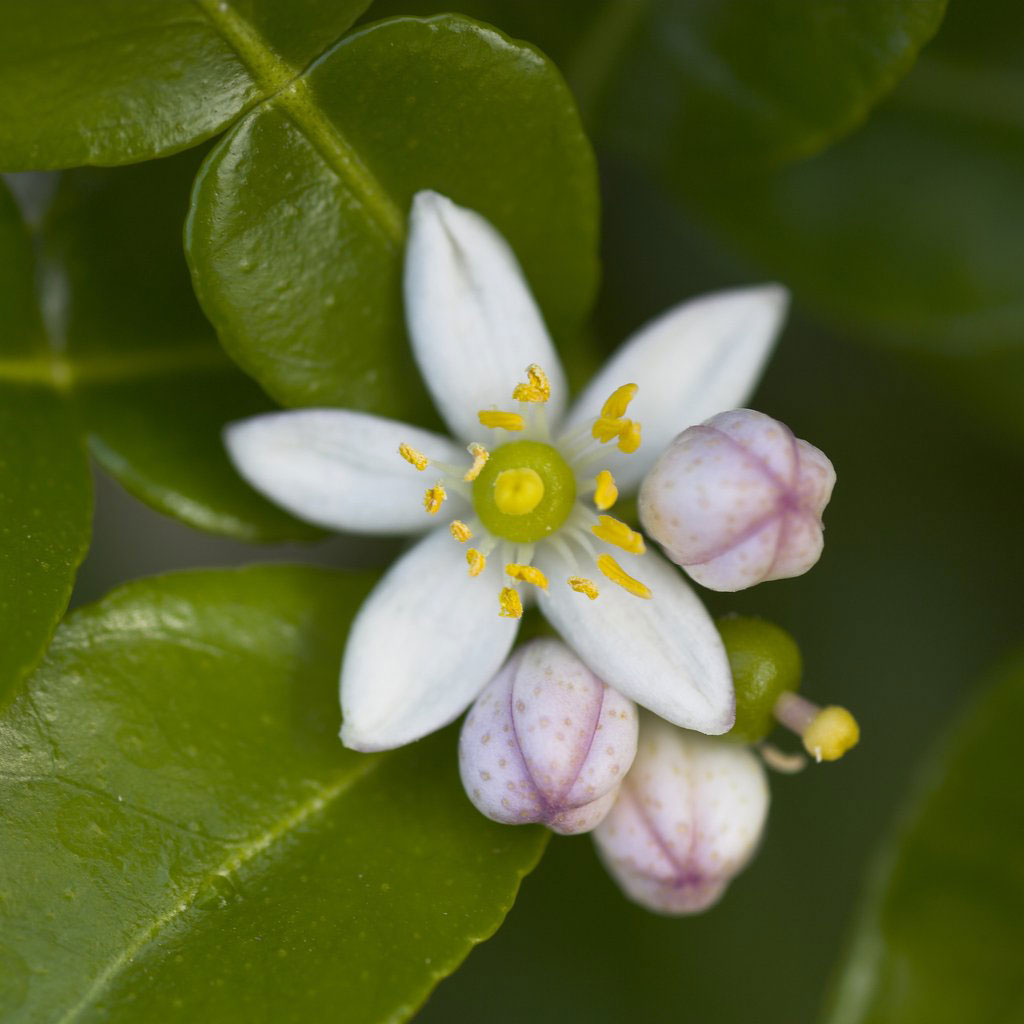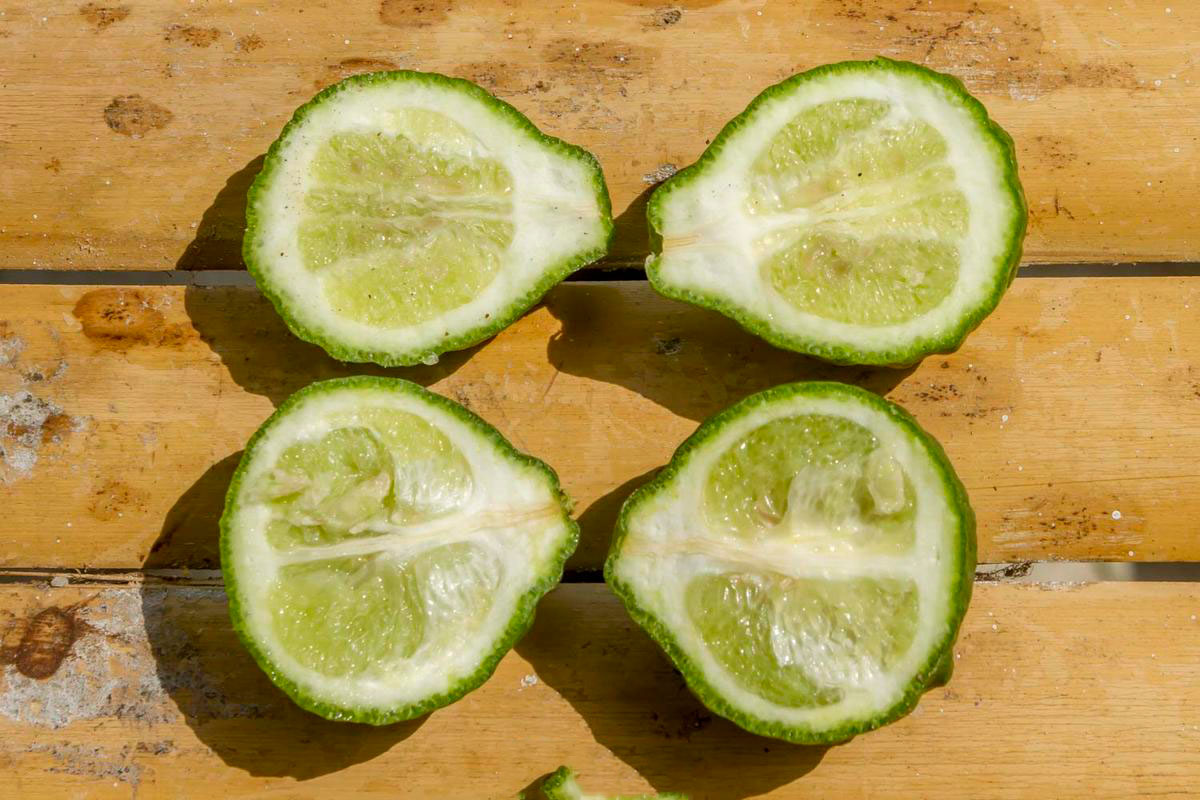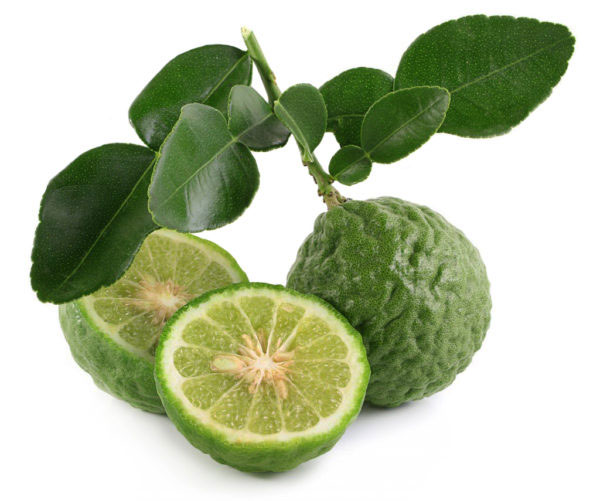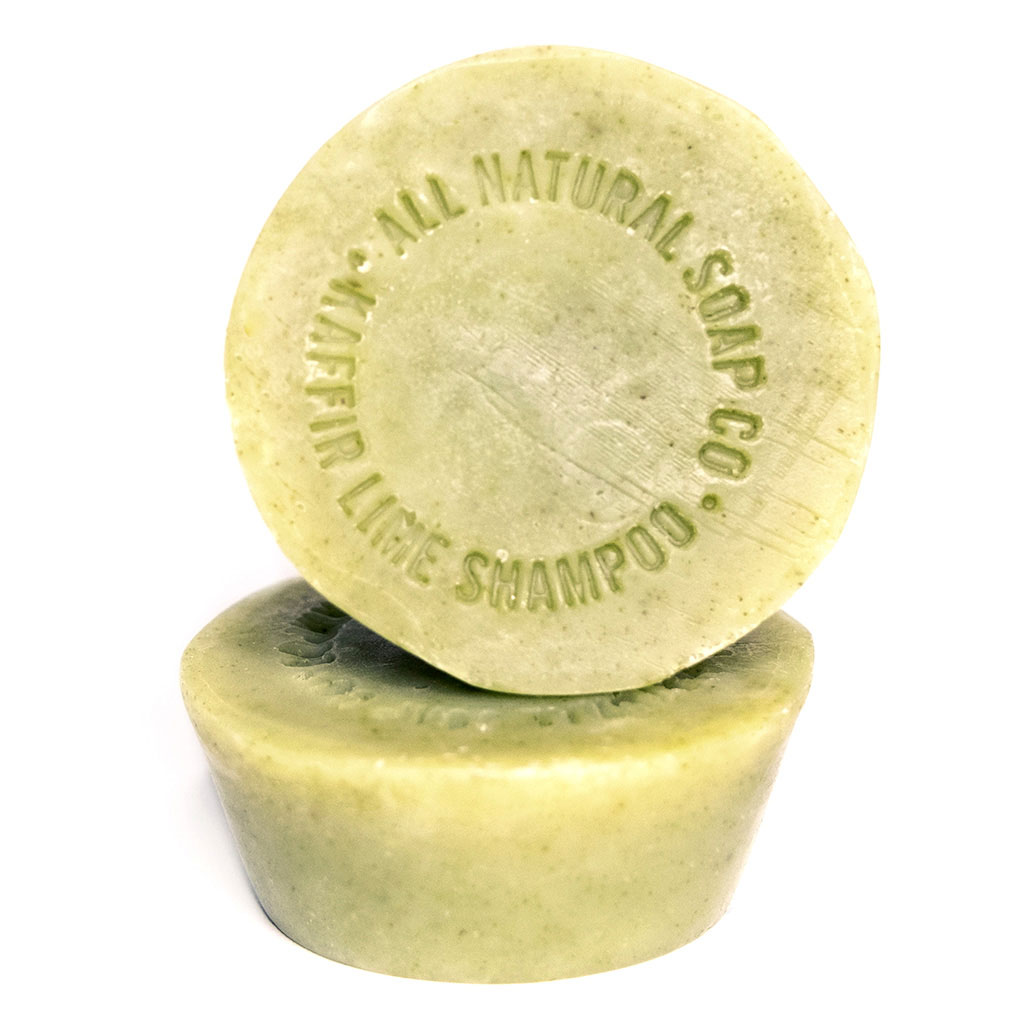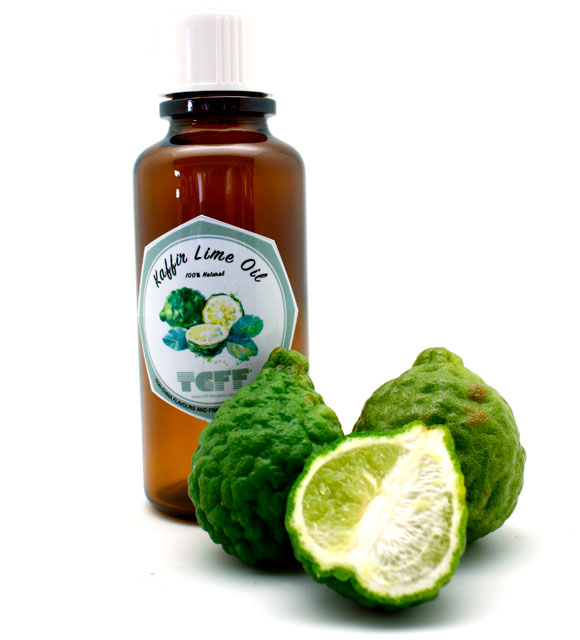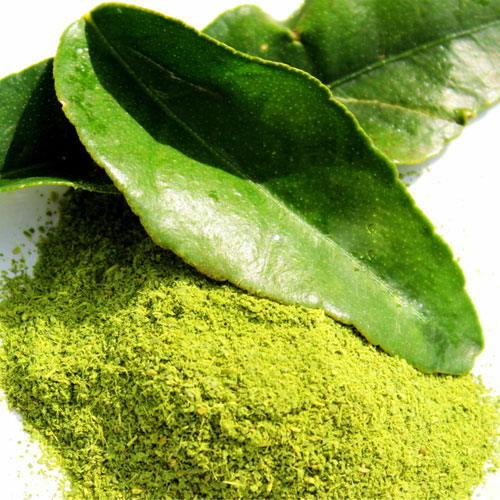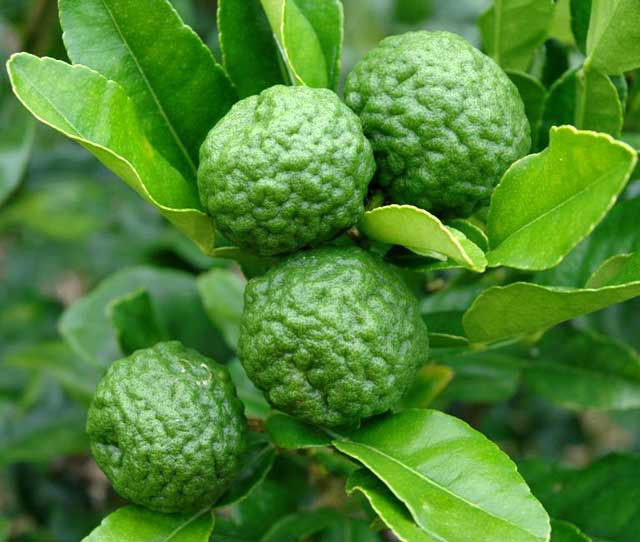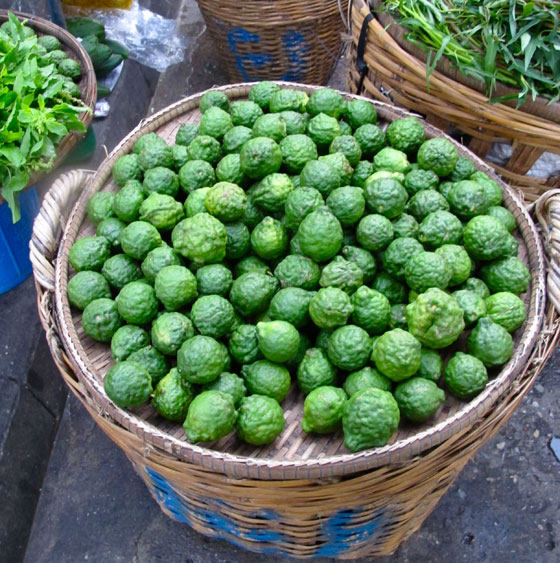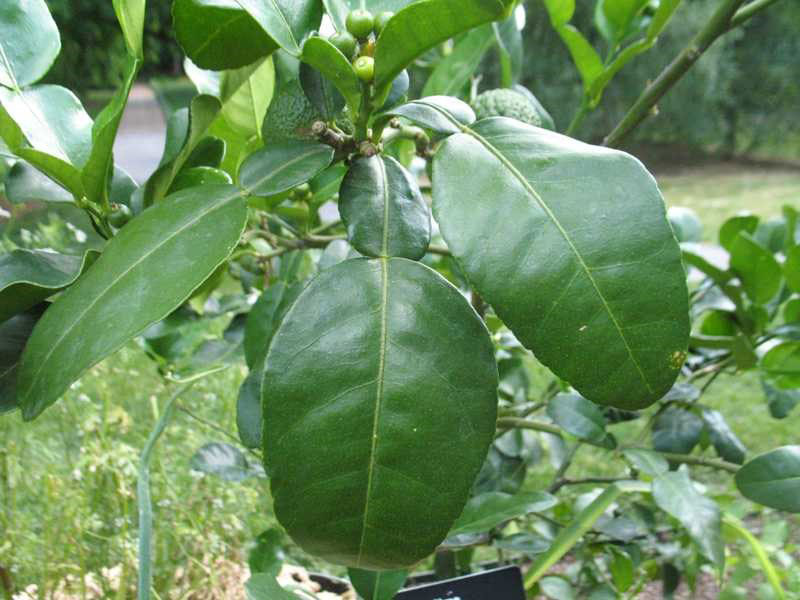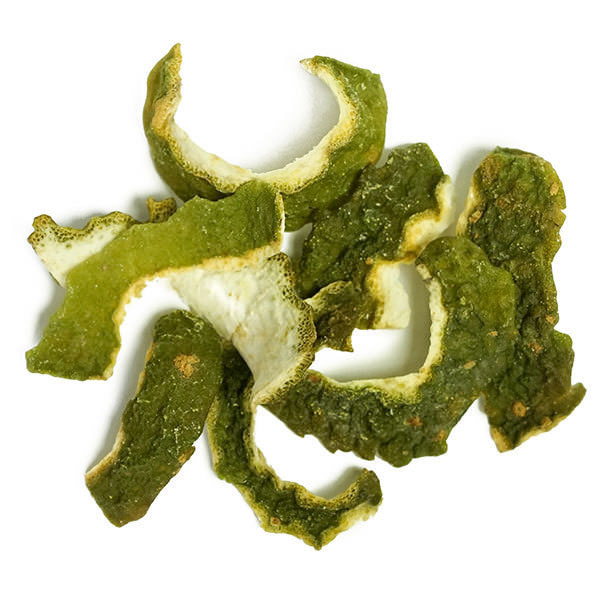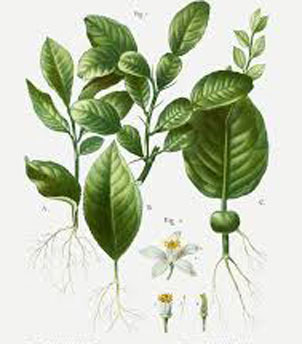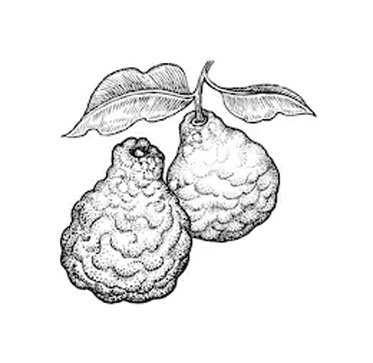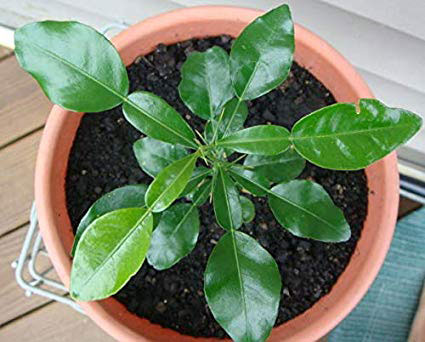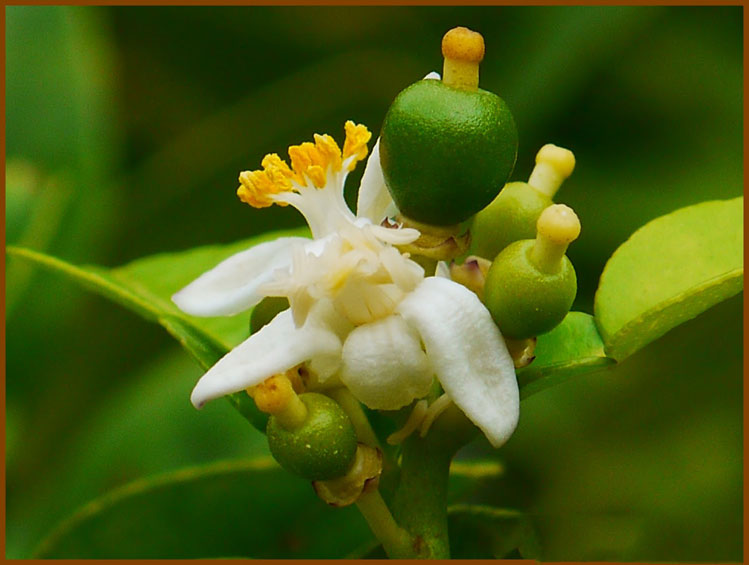“Kaffir” comes from the German word “Kafer”, which means “bug”. This fruit is so named due to the fact that it slightly resembles an insect. Some controversy surrounds the use of the “kaffir” name for this fruit because this word is used by white Afrikaners as a pejorative for black people, meaning “infidel”. This usage derives from the Arabic word “kafir”, which was used by Portuguese explorers to describe native Africans. This word is considered a derogatory term that remains in use today, and as such, alternative names such as Thai, Makrut, Asian, or Wild lime are preferred to ensure no one is offended.
Aside from its culinary uses, due to its uniquely tart and pleasant flavor, kaffir lime is also highly respected in herbal medicine, due to its high content of beneficial organic compounds that can positively affect the body’s systems. The oil, leaves, fruit, and rind of kaffir limes are all utilized for different purposes. Kaffir limes are being used in soups and sauces, such as Tom Yum soup, mainly the leaves, which are frequently utilized in Thai cooking. The leaves and rind are so powerful, however, that they can often overwhelm the flavor of the dish.
Plant Description
Kaffir Lime is a thorny, multi-stemmed, evergreen shrub or small tree that grows about 2 to 11 meters (6 to 35 ft.) tall often not straight, crooked with glabrous and spiny branches. The plant thrives in organic rich, fertile and well-drained acid loam soil and needs sufficient watering during the dry seasons for good growth and fruiting.
Leaves
Leaves are alternate, unifoliolate, and broadly ovate to ovate-oblong, 7.5–10 cm long and 5 cm wide, dark green on top, lighter on the bottom, very fragrant with long petiole expanded into prominent wings. Leaf and expanded petiole appear to be a single pinched leaf. Leaf base is cuneate, or rounded, apex obtuse or slightly acuminate or notched. They are highly aromatic. Glossy, aromatic, double (two-parted), evergreen leaves from this tree are commonly shredded for use as a flavoring in a variety of Southeast Asian food dishes including soups, curries, rice, stir-fry, fish cakes, salads and marinades. Leaves may be harvested from home grown plants or purchased fresh or dried at Asian or specialty groceries.
Flowers & Fruit
Flowers are small, fragrant, white; calyx cuspidate 4-lobed, white with violet fringe. Petals are 4–5, ovate-oblong, yellowish white tinged with pink. Stamens are 24–30 and are free. Fertile flowers are followed by large, verrucose, warty or bumpy globose, ovoid to elliptic, fruits. They are initially green turning yellowish-green when ripe. They are 5–7 cm in diameter; rind is thick, and pulp yellowish, very acid and bitter. So the juice and pulp is infrequently used in cooking. Fruit rinds are sour tasting, but often used for flavoring in a diced-up or grated form. Seeds are numerous, ridged, ovoid-oblong. They are 1.5–1.8 by 1–1.2 cm, mono-embryonic with white cotyledons.
Health Benefits of Kaffir Lime
Some of the leading health benefits of kaffir lime represent its ability to market oral health, detoxify the blood, boost skin health, improve digestion, beat back insects, lower inflammation, aid the system, cut back stress, and improve the health of the hair. Let’s take a slightly closer look at the health benefits of kaffir lime.
1. Treats Digestive Issues
Kaffir lime consists of several components that are also found in lemongrass and related herbs. These organic constituents are anti-inflammatory in nature, but they are also stimulating for the digestive system. If you are suffering from constipation or indigestion, some kaffir lime decoction can clear your symptoms up and get your bowels back on a regular track. This can help prevent more serious gastrointestinal issues in the future, such as colorectal cancer, hemorrhoids, or gastric ulcers.(1)
2. Reduces Stress
Although people don’t think of kaffir limes are particularly useful in aromatherapy, the oil extracted from these powerful fruits can be used aromatically with great effect. If you suffer from anxiety or various nervous disorders, spending some time inhaling these soothing vapors can calm the body and mind. (2)
3. Improves Oral Health
Kaffir lime is quite beneficial in the protection of oral health. However, it is not the fruit itself that should be eaten for this, but rather the rind and the leaves. Leaves can be directly rubbed onto the gums to promote good oral health and remove harmful bacteria that can build up in the mouth. Oil extracted from kaffir limes can also be mixed in with organic toothpaste and mouthwashes to promote stronger oral and gum care. (3)
4. Skin Care
Kaffir lime juice and extracts are mixed into many cosmetic and bath products for its wonderful smell, as well as its antioxidants properties. Few acids found in kaffir limes can help to neutralize free radicals, the dangerous byproducts of cellular respiration that can cause cell mutation or apoptosis, as well as cancer. Antioxidant compounds can also slow the breakdown of cells and lessen the appearance of age marks, scars, and pimples. If you want your skin looking healthy and fresh well into your old age, then perhaps some kaffir lime juice is exactly what you need! (4)
5. Boosts Immunity
Antibacterial and antioxidant qualities of kaffir limes make them powerful tools to boost the immune system. Not only does the topical application prevent infections and bacteria from accumulating on the skin, but when consumed, kaffir limes can help prevent a wide variety of gastrointestinal illnesses and encourage the immune system via antioxidant effects. (5)
6. Detoxifies the Blood
Oil of kaffir limes is often mixed in various decoctions for those suffering from blood-borne illnesses or chronic blood-related diseases. The unique mix of volatile compounds is known to eliminate those pathogens or foreign agents in the blood, while also helping the liver and lymphatic system strain out dangerous substances and improve your overall health. (6)
7. Lowers Inflammation
Kaffir limes can be a wonderful remedy for those who are suffering from rheumatism, arthritis, edema, gout, or some other inflammatory condition. You can use the juice, leaves, or oil extracts topically on the area where you are experiencing discomfort or pain, and you can also consume the fruit and the juices to enjoy a similar effect. This anti-inflammatory effect also makes kaffir lime juice beneficial for headaches and migraines. (7)
8. Hair Care
Applications of kaffir lime juice and leaves are considered quite beneficial for proper hair care. You can apply decoctions and mixtures to the scalp and hair to slow the start of male pattern baldness and strengthen the follicles of the hair. This can also moisturize the skin to prevent dandruff and improves the appearance and shine. (8)
9. Insect Repellant
Kaffir limes are often used for their insect repellant properties. The citronellol and limonene found in kaffir limes are very unappealing to most insects, and when you put a lotion or a salve containing kaffir lime juice/oil on your skin, you can considerably decrease your chances of being bitten by bugs, whether they may infect you or not. (9)
10. Manages Curly Hair Better
Citronella oil, one of the primary constituents in kaffir lime, is quite effective in detangling, helping to make curly hair easier to manage. It also adds volume by infusing an electrical charge on hair strands that cause them to repel each other. It also removes dirt and grease from hair too. It could be added to shampoo to achieve desired effects.
11. Lice Treatment
Kaffir lime extract made from fruit, or combined with the leaves has been used as an all-natural head lice remedy owing to the fact that it constantly kills both the adult parasite and nits.
Head lice are considered parasites, which are very transmissible and spread easily from person to person. Shampoos that take advantage of using the oil in the formulation are amongst the best natural products you can find for treatment of this annoying infestation.
12. Mind Relaxing
Over working and peak life might sometimes drive you mad and stuck into such stressful condition. You hardly sleep and often feel unwell, even though you are not sick. It is not but your mind is getting crowded and need a recharge treatment to make the condition better. These leaves contain relaxation essence which treats your mind and body into a comfortable and pleasant feeling.
You can make your homemade kaffir leaves essence by cutting the leaves into small pieces and scrubbing it with water, let idling for an hour or more and putting it on a bottle to be sprayed into your room. Breathing and smelling the natural smell of kaffir limes leaves will automatically lead you into peaceful and serenity ones.
13. Prohibiting Cancer
Cancer, the biggest and number one dreadful disease in the world has been such a fear for everyone. No one wants to get suffered from cancer since there is no exact medicine has been found yet to cure this disease. Wise people says that preventing is better than curing, that is why you need to stay healthy and aware of cancer stroke by consuming healthy and natural food only. In order to help your body to get healthier, consume kaffir limes leaves will help you to prevent cancer cells growth inside your body. Consume it regularly every day for a better impact.
14. Cure Sprue
Kaffir lime leaves and fruits are one of the biggest sources of vitamin C that work well for curing sprue. Sprue is so annoying since it makes you get stuck of chewing your meal and you cannot even speak or open your mouth. Sprue is caused due to lack water and vitamin C inside your body; moreover, it can be a sign of something going wrong in your organ. Consuming warm water of infused kaffir limes leaves can help you reduce the sprue and boost your immune to produce more Vitamin C.
15. Heal Cough
Bad cough can be quite annoying while you are still in the middle of busy office week. When you have cough, you will usually drink medicine from the drugstore. Meanwhile, you can try to heal it naturally by combining sneezing of kaffir limes leaves with honey or palm sugar and pour them into a cup of warm water. Vitamin C extract containing in the limes leaves can work even better and more natural to heal your cough and make your throat becomes clean and fresh.
16. Heal Fatigues after Sickness
Make the concoctions by boiling kaffir lime extract with fresh tap water with five liters of water. Burn the water until it boiled and then let it cool down for 30 minutes. After that combine with cold water until the water is much warmer and drinkable. Then you can utilize the water for bath therapy.
17. Relaxation Bath
Extracted oil in the leaves is taken and utilizes for many benefits. It is a mixed in various bath products such as soaps and shampoos. The oil is a good for hair and dandruff cleaner, the smell of the leaves is refreshing. Just add a few drops of oil or a few grind leaves to your bath and you will start to throw your negative aura away. It is thought to have a charming effect on the brain and the body and leaves one with inspiration thinking.
18. Air Freshener
Kaffir Limes oil is also mixed in deodorants and sprays perfumes for that extra smell. The oil is also combined in tonics which aid in metabolism and cleanse the blood. Some air fresheners with the kaffir lime aroma rejuvenate the rooms and put out a feeling of a deeply cleaned room. Meanwhile, there are many health benefits of kaffir lime for body and beauty treatment. Indeed, you can try to consume it then.
https://www.youtube.com/watch?v=9GtlxdjWBK4
Kaffir Limes as Food Dressing
Not everyone knows how to consume kaffir limes leaves unless mix them in daily food or drink. It turns out that there are many tips on how to serve kaffir limes leaves to be more consuming friendly for your tongue. You may take a look and get inspired then!
1. Mixing into Salad/Soup
Adding some limes leaves into your salad and soup give not only distinctive fragrance but also contribute great impact of health benefit. Cut the leaves into small pieces and pour them on your salad and soup and they are ready to serve. It would be better to consume your salad or soup a minute after it is done made to make sure the benefits and fragrance of kaffir limes leaves are still mixed well. You may use any kinds of vegetables or fruit as your salad or soup mixing. It is really good!
2. Chili Sauce
Spicy chili sauce can never be better without adding some slice of limes leaves. You can put it into the chili sauce you make or just simply mix it into the sauce. Eat with your favorite food and it is guaranteed that you will have more and more portion for its good fragrance.
Methods of Consuming Kaffir Limes Leaves
Meanwhile, to get the health benefits of kaffir limes leaves, let’s cook it now!
1. Curry Noodle
For those who are having sick and need to eat something smooth but yummy, you can add some more limes leaves into your noodle liquid and let the good fragrance of limes leaves left behind. When our body is sick, it needs a stimulation ingredient to boost the appetite so that your body will not lack of vitamin and nutrition for healing and recovering process. Putting slices of kaffir limes leaves will make your curry noodle be more tasty and yummy. Plus, you get an extra portion of health benefit in it.
2. Limes Leaves Fried Rice
There are more than thousand ways to process kaffir limes leaves into such delicious and healthy meal to consume. For most Asian people, fried rice is their typical menu which never goes wrong. Limes leaves fried rice with additional eggs, meat, or vegetables like tomatoes is such undeniable food which everyone cannot get resist. You can blend the kaffir limes leaves into a powder or smooth slices to get a better function and taste. Serve it warmly and combine with more vegetable like cabbage, cucumber, or tomatoes. It is a brand new and super yummy food creation!
Traditional uses and benefits of Kaffir Lime
- Juice and rinds of the kaffir lime are widely used in traditional Indonesian medicine like jamu and the fruit is sometimes referred to in Indonesia as jeruk obat (medicine citrus).
- Leaves can be used to treat stomach ache caused by dyspepsia and insect bites.
- Fruit and leaves have been used for washing hair; the fruit is halved and the grated rind is rubbed on the head or the whole fruit is boiled and used as shampoo in Peninsular Malaysia.
- Peel has also been used in a general tonic medicine “ubat jamu” and the fruit juice in ointment.
- Rind has also been recommended for treatment for worms and headache.
- Juice and rinds of the peel are used in traditional medicine in some Asian countries; the fruit’s juice is often used in shampoo and is believed to kill head lice.
- Juice is used to keep gums healthy. It is used in brushing teeth.
- Rind as an ingredient is good for the blood and the digestive system.
- Juice is used for washing hair in Thailand.
Culinary Uses
- Fruit and leaves are popular spice ingredient in Asian cooking.
- Leaves impart an aromatic, strong, unique and spicy flavor to many food dishes.
- Leaves can be used fresh or dried, and can be stored frozen.
- Leaves are widely used in Thai cuisine like Tom yum gai (Tom-yum chicken) and tom yum Kung (Tom–yum prawns), Lao cuisine and Cambodian cuisine for the savory paste known as “Krueng”.
- Leaves are used to prepare sayur Assam (salty or sour vegetables) and other spicy curry dishes of fish and chicken and also in sate in Javanese and Balinese cuisine.
- They are also used in Burmese and Malaysian cuisine like beef and chicken Rendang (Minangkabau dish comprising coconut milk and a range of spices that include ginger, galangal, turmeric leaf, lemon grass and chilies).
- Fruit is also used in making sambal, acar (vegetable salad pickled in vinegar dried chilies and ground peanuts) and dalca (mutton curry).
- Juice of the fruit is often used for souring dishes.
- It is also added to fish or meat in order to make them more tender and fragrant or to flavor grilled fish and grilled beef.
- The jus is also made into refreshing drinks.
- Fruit juice is added to sambal petis (chili sauce with shrimp) and also to rojak or petjel (savory spicy sauce) in Indonesia.
- Fruit is used for seasoning and to prepare drinks teas such as Citrus hystrix flavonoid-rich sachet, which has been promoted to have great potential as a natural antioxidant health product in Thailand.
- Peels are dried, preserved and candied.
- Zest of the fruit is commonly used in Creole cuisine and also used to impart flavor to rums in the French Reunion Island and Madagascar.
- Zest of the fruit is used as a flavor in rums.
Recipes
Green chicken curry with noodles
Ingredients
- 3 chicken thighs, bone in, skin on
- 2-3 tbsp. fish sauce
- Freshly ground white pepper, to taste
- 1-liter coconut milk
- 200 g dried Kanom Jin noodles
- 500 ml (2 cups) peanut oil, for frying
- 2 Thai apple eggplants
- Small handful pea eggplants
- 100 g block just cooked pig’s blood, chopped (see Note)
- 1 whole pickled bamboo shoot, finely sliced
- 1-2 knobs wild ginger, finely sliced
- 3-5 kaffir lime leaves
- 1 tbsp. soft coconut palm sugar
Curry paste
- 2 tsp. coriander seeds, toasted
- 1 tsp. cumin seeds, toasted
- 1 tsp. white peppercorns, toasted
- 4 garlic cloves
- 20-30 fresh green Thai bird’s eye chilies
- 2 stalks lemongrass, pale end only, chopped
- 1 small knob fresh turmeric, chopped
- 2-3 large coriander roots, chopped
- 1 tbsp. wild ginger, sliced
- 1 fresh kaffir lime leaf
- I-2 tsp. Thai shrimp paste
- 4 small Asian red shallots
- Thai basil leaves, seeded and thinly sliced long red chilies, to serve
Directions
- Remove the skin from the chicken and place the skin in a bowl with the fish sauce and a pinch of ground white pepper.
- To make the curry paste, place the spices in a large mortar and using the pestle grind until smooth. Add all the remaining ingredients and pound until a paste forms. Alternatively, use a food processor.
- Place 250 ml (1 cup) coconut milk in a wok over medium-high heat and boil until it splits. Add 5 tablespoons curry paste and fry, stirring continuously until the oil reappears. Add the chicken and cook until the oil reappears. Add the remaining coconut milk and simmer until the chicken is just cooked. Remove the chicken, take out and discard the bones, then return the chicken meat back to the curry.
- Drop the noodles into a large saucepan of boiling water. Boil for 5 minutes, then drain and rinse under cold running water. Set aside.
- Meanwhile, heat the peanut oil in a saucepan over a high heat. Deep-fry the chicken skin until golden and crisp. Drain on paper towel.
- Add the eggplant, pig’s blood, pickled bamboo shoot, wild ginger and kaffir lime leaves. Taste and balance the flavor, adding the palm sugar if needed. Reheat the noodles very quickly in boiling water, and then divide between bowls.
- Spoon over the curry and garnish with sliced chilies, basil leaves and crispy chicken skin.
Coconut waffles with caramelized pineapple
Ingredients
- 300 g (10½ oz./2 cups) plain (all-purpose) flour
- 1 tbsp. baking powder
- ¼ tsp. sea salt
- 35 g (1¼ oz./¼ cup) coconut or brown sugar
- 2 eggs, separated
- 500 ml (17 fl oz./2 cups) coconut milk
- 125 ml (4 fl oz./1/2 cup) coconut oil
- finely grated zest of 1 lemon
- 1 vanilla bean, split, seeds scraped
Caribbean rum and coconut caramelized pineapple
- 340 g (12 oz./2 cups) peeled, cored and diced pineapple
- 500 ml (17 fl oz./2 cups) spiced rum
- 1 tbsp. coconut sugar
- 1 tsp. finely grated fresh ginger
- 2 sprigs thyme, leaves picked
- 2 tbsp. coconut flakes
Rock melon and mint salad
- ½ rock melon, sliced into fine ribbons
- 2 mango cheeks, sliced into fine ribbons
- ½ cup mint leaves, chopped
- 70 g (2½ oz./¼ cup) pistachios, toasted and sliced
- 2 lemon myrtle leaves or kaffir lime leaves, finely sliced
- 2 tbsp. honey
- juice of 1 orange
- coconut yogurt, to serve
Directions
- For the waffles, sift the flour, baking powder, salt and sugar into a bowl. Mix the egg yolks with the milk, oil, zest and vanilla seeds. Add the dry ingredients and mix well. Beat the egg whites until firm peaks form.
- Fold gently through the flour mixture. Grease and preheat a waffle iron. Pour ½ cup of the batter into the waffle iron and cook for 4-5 minutes, until golden. Repeat with remaining batter. Serve with your favorite waffle topping.
- For the caramelized pineapple, add the pineapple to a hot frying pan and cook over medium-high heat until tender and caramelized. Meanwhile, mix the rum, sugar, ginger and thyme. When the pineapple is ready, add to the rum mixture and leave to marinate for 2 minutes. Spoon over waffles and garnish with toasted coconut.
- For the salad, mix the rock melon, mango, mint, pistachios and lemon myrtle in a bowl. Drizzle with the honey and orange juice and turn to coat. Serve on top of waffles with coconut yoghurt.
Sumatran egg curry with green sambal
Ingredients
- 1 tbsp. tamarind pulp
- 2 ½ tbsp. vegetable oil
- 500 ml (2 cups) coconut milk
- 1 stalk lemongrass, bruised and tied in a knot
- 8 large hard boiled eggs, peeled
- Steamed rice, sliced green onions and fried shallots, to garnish
Spice paste
- 150 g small pink shallots (about 8), peeled and chopped
- 4 cloves of garlic, chopped
- 6 red birds eye chilies, chopped
- 3 cm piece ginger, peeled and coarsely chopped
- 3 cm piece galangal, peeled and coarsely chopped
- 1 tbsp. chopped fresh turmeric or 1 tsp. ground turmeric
Green sambal
- 150 g large green chilies, trimmed and coarsely chopped
- 75 g small pink shallots (about 4),peeled and coarsely chopped
- 3 cloves of garlic, coarsely chopped
- 1 green tomato (about 150 g), cut into quarters
- 2 kaffir lime leaves, very finely shredded
Directions
- For the green sambal, place the chilies, shallots, garlic and tomatoes in a steamer, cover then cook for 20 minutes or until very soft.
- Transfer to a food processor then using the pulse button, process until a coarse paste forms; do not over process. Transfer to a small saucepan, place over medium-low heat then cook, stirring for 6-7 minutes or until excess liquid has evaporated.
- Stir in the lime leaves then season well with sea salt and freshly ground black pepper. Remove from the heat and cool to room temperature.
- Combine the tamarind pulp in a bowl with 80 ml (⅓ cup) boiling water then stand for 20 minutes or until softened.
- Strain the mixture through a sieve into a bowl, squeezing the solids with your fingers to extract as much liquid as possible – discard the solids and set the tamarind mixture aside.
- For the spice paste, combine all the ingredients in a food processor then process until a smooth paste forms.
- Heat the oil in a saucepan over medium then add the paste and cook, stirring, for 2-3 minutes, or until fragrant.
- Add the coconut milk, lemon grass and tamarind puree and bring to a simmer. Reduce heat to low then cook, covered, for 10 minutes to allow the flavors to develop.
- Add the eggs then simmer, uncovered, for 6-7 minutes or until the liquid has reduced slightly.
- Serve with rice and garnished with green onions and fried shallots, with the sambal to the side.
Other Facts
- Oil extracted from the rind is used in cosmetics and beauty products.
- Extracts from the fruit skin as well as juice are used as an insecticide for washing the head and treating the feet to kill land leeches and as a bleach to remove tough stains.
- Timber is used for tool handles and the juice may be used as an adjunct in dyeing with annatto.
- Essential oil from kaffir lime leaves was found effective in killing larvae of tobacco army worm, Spodoptera litura.
- Essential oil also displayed anti-feedant properties resulting in severe growth inhibition of the insect.
- Oil abstracted from the rind has strong insecticidal properties.
- Holy water mixed with slices of the fruit is used in the religious ceremonies in Cambodia.
- Juice of the fruit can also be used as a detergent for clothing.
- It is used as natural bleach for the removal of tough stains.
- Believed that Kaffir lime juice is substance to thwart the evil spirits and rejuvenate a person’s mental status.
- Vietnamese used it while steaming snails to reduce pungent odor.
- Cambodia people mix the fruit and water and use it during religious ceremonies.
Precautions
- Due to the potency of the extracted oil of kaffir limes, it is not recommended for direct consumption, as it can result in nausea, vomiting, dizziness, lightheadedness, and other unpleasant side effects.
References:
https://www.itis.gov/servlet/SingleRpt/SingleRpt?search_topic=TSN&search_value=825206#null
http://www.hear.org/pier/species/citrus_hystrix.htm
https://plants.usda.gov/core/profile?symbol=CIHY2
https://davesgarden.com/guides/pf/go/67460/#b
https://en.wikipedia.org/wiki/Kaffir_lime
https://en.wiktionary.org/wiki/Citrus_hystrix
http://www.theplantlist.org/tpl1.1/record/kew-2724129
https://indiabiodiversity.org/species/show/225573
http://gernot-katzers-spice-pages.com/engl/Citr_hys.html
https://npgsweb.ars-grin.gov/gringlobal/taxonomydetail.aspx?id=10714
https://gd.eppo.int/taxon/CIDHY
https://citrusvariety.ucr.edu/citrus/hystrix_2454.html
Comments
| Kaffir Lime Quick Facts | |
|---|---|
| Name: | Kaffir Lime |
| Scientific Name: | Citrus hystrix |
| Origin | Tropical southeast Asia, southern China, Malaysia, Indonesia, Thailand, and the Philippines |
| Colors | Green turning yellowish-green when ripe |
| Shapes | Large, verrucose, warty or bumpy, globose, ovoid to elliptic, 5–7 cm diameter |
| Flesh colors | Yellowish |
| Taste | Sweet |
| Health benefits | Treats Digestive Issues, Reduces Stress, Skin Care, Improves oral health, Boosts Immunity, Detoxifies the Blood, Lowers Inflammation, Hair Care, Insect Repellant, Manages Curly Hair Better, Lice Treatment, Mind Relaxing, Prohibiting Cancer, Cure Sprue, Heal Cough, Heal Fatigues after Sickness, Relaxation Bath, Air Freshener, |
| Name | Kaffir Lime |
|---|---|
| Scientific Name | Citrus hystrix |
| Native | Tropical southeast Asia, southern China, Malaysia, Indonesia, Thailand, and the Philippines |
| Common Names | Kaffir lime, Mauritius papeda, Makrut lime, papeda, leach lime, rough lemon, Indonesian lime leaves, limau purut, Mauritius bitter orange, Thai limes, Caffir Lime, Ichang Lime, Porcupine Orange, Porcupine Orange Lime, Thai Bai Makrut, Wart Lime, Wild Lime, Kaffir Citrus, Nardanga, Kieffer lime, Shauk-nu, Swangi, Som makrut, Jeruk sambal |
| Name in Other Languages | Bengali: Kāphira lēbu (কাফির লেবু) Bokmål: KaffirlimeBurmese : Shauk Cho, Shouk-Pote, Shauk Nu, Shauk Waing, taw shout hkarr (တောရှောက်ခါး) Chinese : Ma Feng Gan, Mao Li Qiu Si Ku Cheng, Ma Feng Cheng, Ma Feng Mao Gan Fatt-Fung-Kam, Thai-Ko-Kam Czech : Kaffir Citrus Danish : Kaffir Lime Dutch : Indonesische Citroenboom, Kaffir Limoen, Djeroek Poeroet, Mauritius papeda Eastonian : Kaffir Laimilehed English: Kaffir lime, Mauritius papeda, Makrut lime, papeda, leach lime, rough lemon, Indonesian lime leaves, Wild lime, kieffer lime, limau purut, Mauritius bitter orange, Thai limes Estonian: Kahvri laimipuu Finnish : Kaffir Limetti, Ryppylimetti French : Combava, Limettier Hérissé, Citron Combara, makrut German : Indische Zitrone, Indische Zitronenblätter, Indonesische Zitronenblätter, Kaffir Limette, Makrut Limette, Langdorniger Orangenbaum, Kaffirzitrone, langdorniger Apfelsinenbaum, Mauritius-Papeda Guam : Limon Admelo Hebrew : Aley Kafir Laim Hungarian : Kaffercitrom, Kaffir Citrom ÉsLevél India : Kolumichai, maltaa Indonesia : Juuk Purut, Jeruk Purut, Jeruk Obat, Jerut Sambal, Limo Purut, Daun jeruk purut Italian: combava, papeda delle Mauritius Japanese : Bai Makkuruu, Kobu Mikan (コブミカン), Moorishasu Papeda, Kafaa Raimu, Purutto, Kafiiru Raimu, Kobu Mikan Javanese: Jeruk purut Khmer: Kraunch Soeuth, Slirk-Krote Sirk Kiribati : Te Remen Komi: Kafir-laĭm (Кафир-лайм) Laos: Khi-Hout, Makgeehoot, mak khi hud (ໝາກຂີ້ຫູດ) Malay: Limau purut, Daun limau purut Malaysia : Limau Purut, Limau Hantu, Limau Suwangi Palauan : Debechel Persian: لیموی کفیر Philippines : Kabog, Kamuntai, Kolison, Kolobot, Amongpong, Amontau, Kolo-Oi, Kopalian, Mayagarin, Kapitan, Kamugau, Kamukau, Kamulan, Kapitan, Pinukpuk, Piris, Malatbas ( Sambali), Muntai, Daruga, Duroga, Buyak, Buyog, Kabuan, Kabugau, Kobot, Kolobot, Kolong-Kolong Polish: Papeda Portuguese: Combava, lima-de-cafir, papeda Reunion Island : Combava Russian : Kaffir Laim, Kafrskii Laim, Кафир-лайм Samoan : Tipolo Patupatu Slovenian: Kombava Sri Lanka : Kahpiri Dehi, Kudala Dehi, Odu Dehi Spanish : Naranja Puerco-Espín, Hojas De Lima Cafre, Hoja De Lima Kaffir, Lima Kaffir Sundanese: Jeruk purut Swedish: Kafirlime, Papeda Thailand: Bai Makrut, Luuk Makrut, Luuk Makruut, Ma-Kruut, Magood, Magrood, Makrut, Makut, Som Makrud, Makrūd (มะกรูด), Lūk makrūd (ลูกมะกูด), Bı makrūd (ใบมะกรูด), Makrut, Makut, Magood Tongan : Lemani, Moli Lemani Tuvaluan : Laim Vietnam : Chanh Kaffir, Chanh Sác, Trúc, Trấp Yapese : Gurgur Gurgumimarech |
| Plant Growth Habit | Thorny, multi-stemmed, evergreen shrub or small tree |
| Soil | Thrives in organic rich, fertile and well-drained acid loam soil and requires adequate watering during the dry seasons for good growth and fruiting |
| Plant Size | 2 to 11 meters (6 to 35 ft.) tall |
| Leaf | Alternate, unifoliolate, broadly ovate to ovate-oblong, dark green on top, lighter on the bottom, very fragrant with long petiole expanded into prominent wings, 15 cm long by 5 cm wide |
| Flower | Small, fragrant, white; calyx cuspidate 4-lobed, white with violet fringe; petals 4–5, ovate-oblong, yellowish white tinged with pink; stamens 24–30 free |
| Fruit Shape & Size | Large, verrucose, warty or bumpy, globose, ovoid to elliptic, 5–7 cm diameter |
| Fruit Color | Green turning yellowish-green when ripe |
| Fruit Skin | Thick |
| Flesh color | Yellowish |
| Seed | Numerous, ridged, ovoid-oblong. 1.5–1.8 by 1–1.2 cm, mono-embryonic with white cotyledons |
| Flavor/Aroma | Intense citrus fragrance |
| Taste | Sweet |
| Plant Parts Used | Root, bark, leaves, fruit |
| Season | By seeds and grafting |
| Health Benefits |
|


